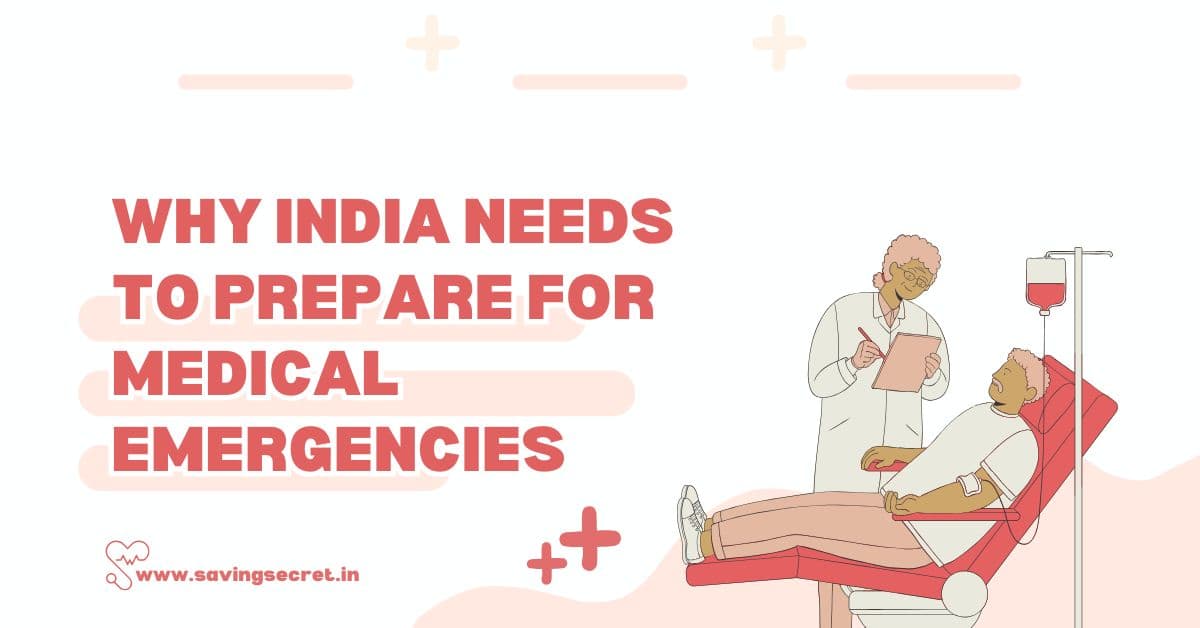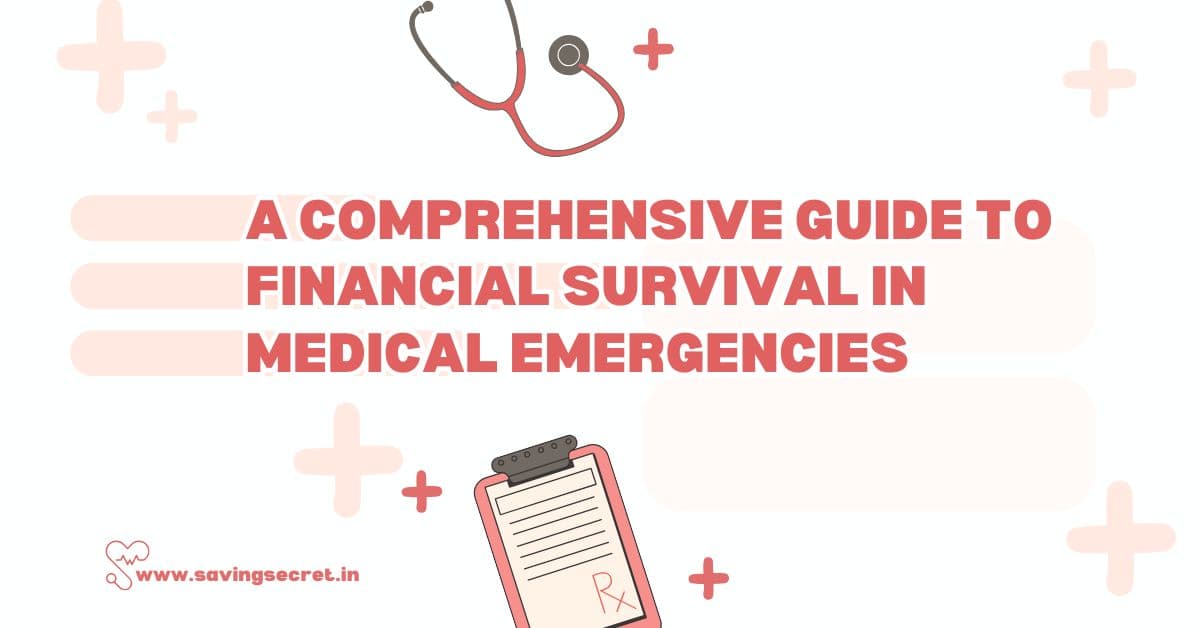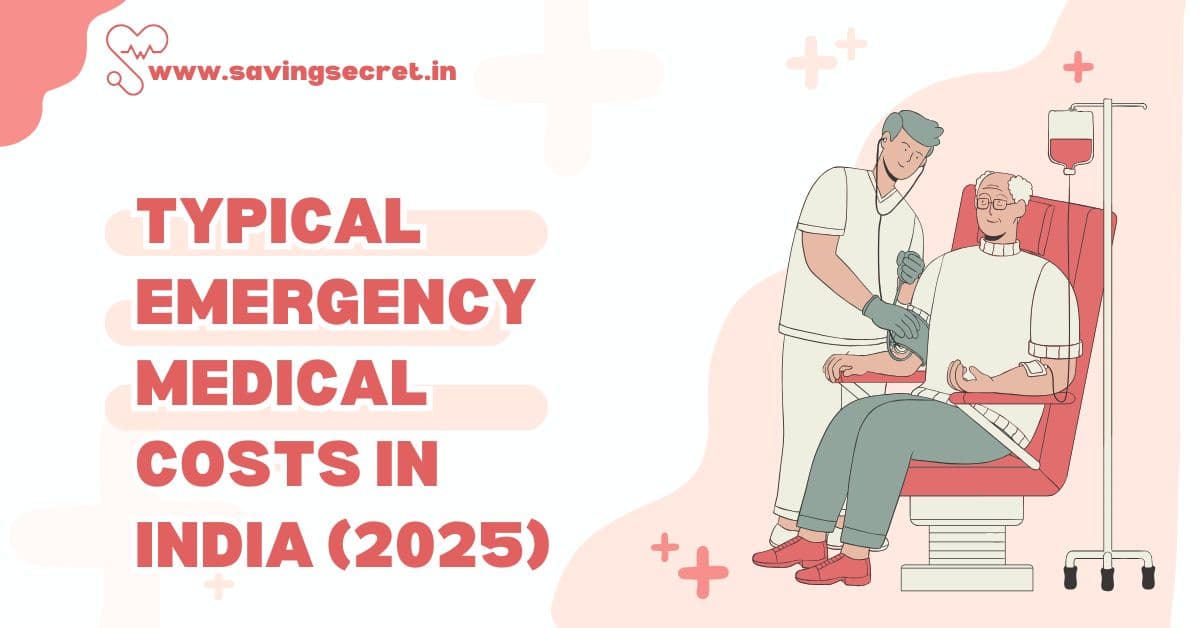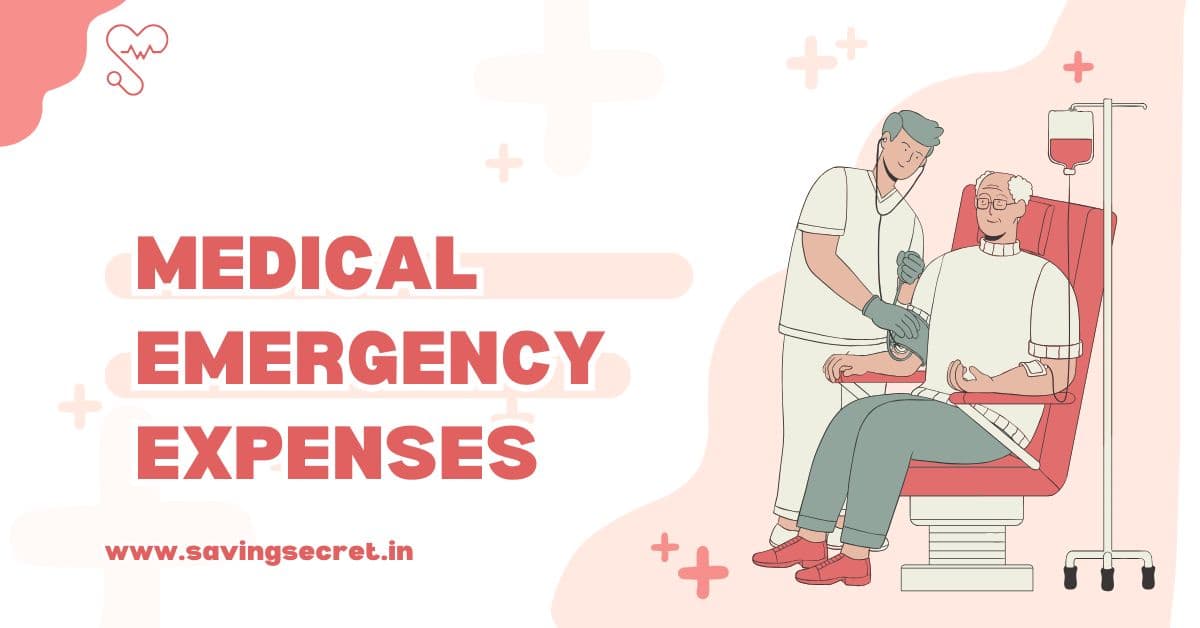Medical Emergency Expenses? Here’s Your Financial Survival Guide: Medical crises may happen at any time, and if you’re not prepared, they can have a devastating financial impact in India, where healthcare expenses are growing quickly. Depending on the treatment and location, a single medical emergency might cost anywhere from ₹50,000 to ₹10 lakh or more, including hospitalisation fees and critical care charges. It is therefore imperative for Indian families to plan for such unanticipated costs, particularly in major cities like Bangalore, Delhi, or Mumbai.
This financial survival guide for Indian readers offers practical ways for planning and managing medical emergency expenditures. This in-depth post will provide you the skills, advice, and resources you need to protect your money from medical emergencies in 2025, regardless of whether you’re a young professional, a salaried worker, or a family provider.
Why India Needs to Prepare for Medical Emergencies
Although it is becoming better, India’s healthcare system still faces some difficulties:

- Increasing expenses: A 2024 research states that ICU stays in private hospitals now cost between ₹20,000 and ₹50,000 per day, with hospitalisation expenses increasing by 8–10% yearly.
- Limited Public Healthcare: Although reasonably priced, government hospitals are sometimes congested, forcing many people to seek care at private institutions.
- Out-of-Pocket Costs: In India, more than 60% of medical expenses are covered out of pocket, although the worldwide average is between 20% and 30%.
- Impact of Inflation: Savings are reduced as medical inflation (10–12% yearly) surpasses ordinary inflation (4–6%).
A medical emergency might wipe away money, compel you to sell investments, or put you in debt if you don’t have a safety net. This manual provides doable actions to increase resilience and efficiently handle medical emergency costs.
A Comprehensive Guide to Financial Survival in Medical Emergencies
To be ready for and handle medical crises in India, use these useful tips.

1. Establish an Emergency Fund
Your first line of defence in the event of a medical emergency is an emergency fund. Save as much as six to twelve months’ worth of living expenditures, giving liquidity and accessibility a priority.
- How Much to Save: Depending on lifestyle and dependents, families should aim for ₹3–5 lakh, but for a single individual, ₹1-2 lakh is a fair starting point.
- Where to Save: For immediate access, keep money in a sweep-in fixed deposit (FD), liquid mutual funds, or a savings account. Keep your money out of long-term investments like PPF.
- How to Build: Set aside ten to twenty percent of your monthly income. For instance, save between ₹5,000 and ₹10,000 each month on a salary of ₹50,000.
Context: An emergency fund cannot be negotiated in places like Delhi or Mumbai, where a single hospital stay might cost between ₹1 and ₹3 lakh. To automate saves and monitor progress, use applications such as ET Money or Moneycontrol.
Pro Tip: To prevent using money for non-essential items, open a second savings account for emergencies.
2. Make a Comprehensive Health Insurance Investment
One essential instrument for defraying the costs of medical emergencies is health insurance. Hospitalisation, operations, tests, and post-hospitalization costs are all covered by a decent insurance.
Important Qualities of a Health Insurance Plan
- Sum Insured: Taking into account growing medical expenses, select ₹5–10 lakh for individuals or ₹15–25 lakh for families.
- No Sub-Limits: Steer clear of plans that limit coverage due to disease-specific caps or room rent.
- Critical Illness Coverage: Include riders for illnesses that might cost between ₹5 and ₹20 lakh to cure, such as cancer or heart issues.
- Cashless Facility: Choose insurance companies like Apollo, Fortis, and Max that have a large network of cashless hospitals.
- Prior to and following hospitalisation, make sure that follow-up care (30–90 days) and diagnostics are covered.
- Minimal Waiting Period: Seek out pre-existing condition waiting periods of no more than one to two years.
Leading Indian Health Insurance Companies (2025)
- Star Health: renowned for its wide hospital networks and reasonably priced plans.
- Comprehensive family floater policies with riders for critical illnesses are available from HDFC ERGO.
- ICICI Lombard: Well-liked for wellness benefits and cashless claims.
- Care Health: Offers affordable premiums for high sum insured alternatives.
Cost: Family policies with four people ranging from ₹20,000 to ₹40,000 each year, while a 30-year-old policy for ₹10 lakh costs between ₹8,000 and ₹15,000.
Context: Insurance is essential since private hospital fees for procedures sometimes surpass ₹2 lakh. To locate the best match, compare plans on websites such as Coverfox or Policybazaar.
Pro Tip: To lock in cheaper rates and prevent increased expenses as you age, purchase insurance early (in your 20s or 30s).
3. Recognise Your Company’s Health Benefits
Employees and occasionally families are covered by the group health insurance offered by several Indian businesses. These proposals, though, can have drawbacks:
- Low Coverage: The quantity covered under group policies is often between ₹2 and ₹5 lakh, which is insufficient for serious situations.
- Dependents: Parents may not be covered or may need to pay higher rates.
- Job Loss Risk: If you quit, your benefits stop.
Useful Tip: Add a personal policy to your employer’s insurance. For instance, purchase a ₹7–10 lakh individual plan to make up the difference if your workplace offers ₹3 lakh coverage.
Context: Relying exclusively on employer insurance is dangerous in IT hotspots like Bangalore or Pune, where employment changes are frequent.
4. Examine Government Health Programs
India has a number of publicly funded health programs to lower out-of-pocket costs:
- Ayushman Bharat (PM-JAY): Offers secondary and tertiary care at hospitals that are affiliated with the program for up to ₹5 lakh per family per year. suitable for economically disadvantaged groups.
- The Central Government Health Scheme (CGHS) provides cashless medical care to central government employees and retirees.
- State-Specific Programs: Low-income households are covered by initiatives like Maharashtra’s Mahatma Jyotirao Phule Jan Arogya Yojana and Tamil Nadu’s Chief Minister’s Comprehensive Health Insurance Scheme.
Useful Advice: Verify your eligibility on the websites of the state health departments or the Ayushman Bharat portal. Prepare your income and Aadhaar papers for enrolment.
Context: These programs may not cover private hospitals in major cities, but they are a lifeline for families in rural and semi-urban areas.
5. Establish a Budget for Medical Emergencies
Having a specific budget helps you keep costs under control and avoid financial ruin in the event of a medical emergency.
How to Make a Budget for Medical Emergencies
- Estimate Costs: Look up the typical prices for popular treatments (e.g., heart surgery: ₹3–8 lakh; appendectomy: ₹50,000–₹1.5 lakh).
- Set Expense Priorities: Reduce frivolous spending (subscriptions, eating out) and concentrate on necessities (medical costs, hospital bills).
- Leverage Insurance: Reduce out-of-pocket expenses by timely filing claims.
- Negotiate Bills: Ask hospitals for reductions or look into payment options for expensive bills.
Context: To prevent overcharging in private hospitals, request itemised bills. For advance payments, several hospitals provide savings of 5–10%.
Tool Tip: Track emergency-related costs and reallocate your money by using applications like ZeeMoney or Money View.
6. Examine crowdfunding or medical loans
If money and insurance are insufficient, consider the following options:
- Medical Loans: Loans with terms of one to five years and interest rates between 10 and 15 percent are available from banks such as SBI, HDFC, or NBFCs like Bajaj Finance. For current clients, pre-approved loans guarantee prompt disbursement.
- EMI Options: For interest-free or low-interest EMIs on bills, several hospitals collaborate with financiers (like Bajaj Finserv).
- Crowdfunding: You may generate money for necessary therapies, particularly for impoverished families, via platforms like Milaap or Ketto.
Context: Medical loans are frequently taken out in cities, but be sure you can afford to pay them back to avoid getting into debt traps.
Pro Tip: To locate the best interest rates, compare loan conditions on BankBazaar or Paisabazaar.
7. Continue to Practice Proactive Preventive Care
Prevention is more cost-effective than treatment. Decrease the probability of crises by:
- Frequent Checkups: Annual health screenings, which cost between ₹2,000 and ₹5,000, might identify problems early.
- Healthy Lifestyle: Stress reduction, a balanced diet, and exercise reduce the chance of developing chronic illnesses.
- Vaccinations: To avoid expensive diseases, stay up to date on immunisations (such as those for hepatitis and the flu).
Context: Cost-effective health plans designed for Indian families are provided by diagnostic chains such as Dr. Lal PathLabs and Thyrocare.
Typical Emergency Medical Costs in India (2025)
To properly plan, be aware of the average expenses at private hospitals:

General ward hospitalisation costs between ₹5,000 and ₹15,000 per day.
Daily ICU Stay: ₹20,000 to ₹50,000.
Procedures:
- From ₹50,000 to ₹1.5 lakh for an appendectomy.
- ₹2 to 5 lakh for an angioplasty.
- Treatment for cancer: ₹5–20 lakh.
Diagnostics: blood tests cost ₹1,000 to ₹5,000; MRI/CT scan: ₹5,000 to ₹15,000.
Critical care medications cost between ₹10,000 and ₹50,000.
Context: Compared to Tier-2/3 cities, metro areas have 30–50% higher costs. Although they may have higher wait times, government hospitals charge 10–20% of private hospital prices.
Indian Families: Issues and Solutions
Problem 1. The first challenge is high out-of-pocket expenses.
Savings are strained since more than 60% of medical costs are paid for directly. Solution: Keep a sizable emergency reserve and give health insurance first priority.
Problem 2: Insufficient Insurance Protection
With ₹1–3 lakh plans that are insufficient for serious situations, many Indians lack adequate insurance. The answer is to add riders for essential illnesses and increase coverage to ₹10–25 lakh.
Problem 3: Access to Healthcare in Rural Areas
Due to a shortage of good hospitals in rural regions, patients must go to cities. Solution: Sign up for Ayushman Bharat and look at telemedicine consultation sites such as Practo.
Problem 4: Lack of knowledge about finances
Many Indians don’t know much about disaster preparedness or insurance. Solution: Use Zerodha Varsity for financial education, or follow YouTube personalities like Ankur Warikoo and CA Rachana Ranade.
Resources and Tools for Indian Families
- Comparison of Insurance: Policybazaar, Insurancedekho, and Coverfox.
- Apps for budgeting include ZeeMoney, ET Money, Moneycontrol, and Money View.
- Platforms for crowdfunding: ImpactGuru, Ketto, and Milaap.
- State health websites, CGHS, and Ayushman Bharat are examples of government portals.
- Providers of health examinations: Apollo Diagnostics, Thyrocare, and Dr. Lal PathLabs.
- Learning Resources: YouTube channels (Pranjal Kamra, Ankur Warikoo), SEBI’s investor portal, and NSE India.
Conclusion
Indian families can deal with medical emergencies with confidence if they have the proper financial plan in place. The key to financial survival is having a sizable emergency fund, purchasing full health insurance, taking advantage of government programs, and being proactive with preventative treatment. You can safeguard your funds, stay out of debt, and guarantee that you and your loved ones receive high-quality healthcare by making advance plans.
Call to Action: Get started right now! Create a monthly emergency fund of 2,000 to 5,000 and check your policy on Policybazaar. For peer guidance, join groups like r/IndiaInvestments or leave a comment with your financial readiness suggestions!
Effective Chit Fund Debt Solutions for Middle-Class Indians
Gold Loan vs Personal Loan: Which is Better for Debt Relief?
Loan Repayment Made Easy: Your Money Map

